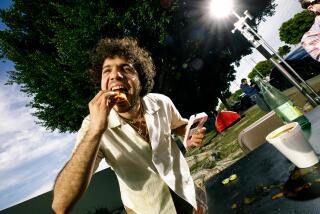In ‘Anything That Moves,’ Dana Goodyear dives into the foodie phenomenon
It seems there is nothing Dana Goodyear won’t put in her mouth. Pig ears, beef hearts, crickets, stink bugs and ox penis are just a few of the things she knowingly chews up and swallows.
In her new book, “Anything That Moves: Renegade Chefs, Fearless Eaters, and the Making of a New American Food Culture,” she goes deep into the counterculture of the foodie movement, unearthing black market butter dealers and unethical caviar hustlers; haute cuisine presented in apartments and endangered species served in pricey sushi bars. She meets bug eaters, slime suckers, blood drinkers and other food fanatics from all walks of life.
To her great credit, she is right there with them, eating things that most of us would, given a choice, not put in our mouths.
Books: Sign up for our email newsletter, “Bookshelf”
Goodyear attempts to sum up foodie culture, noting: “Its shared values are a love of the special, sub rosa, small-batch, and handmade and a loathing of homogeneity, mass production, and uniformity.”
I agree with that assessment; at its best, the foodie phenomenon is about developing an appreciation for other cultures, learning about new and different ways of cooking and eating, and showing respect for the life of the animal that you’re consuming by not wasting any part of it, eating snout to tail.
At its worst, foodie culture is a parade of egomaniacal one-upmanship where gobbling down poached genitalia or endangered slime, insect pupae or some arcane gland, is a badge of honor to be flashed at cocktail parties and documented on blogs and social media sites. At that point, it becomes a kind of self-indulgence, the dark side of hedonism, as offal-breathed foodies boast of impossible-to-find secret restaurants and recount the gamy aftertaste of roasted prairie dog.
Goodyear attempts to show both of these aspects of foodie culture, but she’s clearly on the side of the adventurous eaters. As she says in the introduction to the book, “this movement is about pleasure — pleasure heightened at the brink of calamity.”
She begins her journey with an “apprenticeship” with The Times’ own food critic, Jonathan Gold, tagging along with him as he rampages through the dining rooms of Los Angeles and painting a sympathetic portrait of an erudite gourmand on a mission to find the funkiest of flavors. Gold is “the patron saint of foodies” who has inspired a generation of adventurous eaters and, as Goodyear says, “For Yelpers, Tweeters, bloggers, and other eating documentarians, Gold is also the one to beat.” To understand foodie culture, Goodyear decides to walk in his footsteps, declaring: “I will eat disgusting things, but only those with long established culinary traditions.”
She begins by placing the foodie movement in a historical context, recounting the rise of specialty food importers and how they slowly persuaded Americans to augment their diet of meat and potatoes by trying new things such as smoked oysters, goat cheese and water chestnuts — foods we take for granted nowadays.
Naturally, once Americans started eating exotic food such as caviar and huitlacoche, it was only a matter of time before someone made a “Bee-LT” sandwich with the embryonic drones of honey bees. Goodyear, along with such chefs as Laurent Quenioux, who, it turns out, will go to extreme lengths to acquire the giant ant eggs called escamoles, isn’t shy about munching bugs. The Bee-LT, for example, is “fatty and a little bit sweet, and, like everything chitinous, left me with a disturbing aftertaste of dried shrimp.”
Insects act as the gateway food, and she’s soon running around Las Vegas with exotic food hustlers, going to secret gatherings of raw milk fanatics, and meeting egg aficionados who favor ova so fresh that they retain a certain “pooey” charm. She watches as a marijuana-themed tasting menu is created (a dinner I really should’ve been at) and recounts the capture of parties involved in an endangered whale sashimi conspiracy.
Although it’s great fun to meet these foodie freaks, Goodyear doesn’t stop there; she’s a serious journalist, a staff writer for the New Yorker — where, it should be noted, several of these chapters have appeared in a slightly different form — and her research and eye for the historical connection to these trends enriches the narrative.
I was, however, disappointed that she neglected the noncarnivorous side of foodie culture, the vegan and vegetarian chefs and eaters — such as local heroes Hot Knives — who are as much a part of the new American food culture as the people sliding seared lamb brains down their gullets. This oversight mars what could’ve been the definitive book on the nascent foodie movement.
One aspect of the book I found particularly delightful was the accidental portrait of Los Angeles that emerges in these stories. As Goodyear bounces around the city, from slippery Chinese noodle shops to Kogi taco trucks, from the organ grinders at Animal to Wolvesmouth’s haute cuisine prepared in a small downtown loft, from raw goat milk sold out of a truck on the Westside to the bizarre Filipino duck embryo delicacy balut on the East, the true nature of our global ingredient, poly-flavored city is revealed.
Goodyear is a witty writer with a sly humor that makes her a genial guide to such a strange and diverse counterculture, and her playful sense of irony lets us know that even though she is eating a dessert made of the fallopian tubes of frogs, she’s in on the joke, she knows it’s gross, but she’s a foodie and can’t resist having a taste.
Haskell Smith is the author of “Heart of Dankness: Underground Botanists, Outlaw Farmers, and the Race for the Cannabis Cup.”
Anything That Moves
Renegade Chefs, Fearless Eaters, and the Making of a New American Food Culture
Dana Goodyear
Riverhead: 272 pp., $27.95
More to Read
Sign up for our Book Club newsletter
Get the latest news, events and more from the Los Angeles Times Book Club, and help us get L.A. reading and talking.
You may occasionally receive promotional content from the Los Angeles Times.






